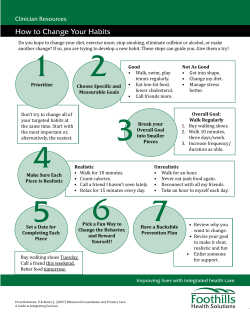
Eat Like A Caveman: The Paleo Diet
Cyan A7 magenta A7 yellow A7 black A7 The Gazette Wednesday, March 25, 2015 A7 healthhappiness&harmony healthhappiness&harmony Eat Like A Caveman: The Paleo Diet By Sam Erickson By now, you’ve probably heard of it. You might even know someone that has tried it. It’s the Paleo diet. The simple idea behind the diet is that human bodies haven’t evolved enough since the caveman days to deal with the complex diets eaten today. By simplifying the diet, advocates say, human bodies can work more efficiently, leading to a reduction in weight and a healthier overall lifestyle. Foods that were available during the Paleolithic era include meat, eggs, fish, roots, vegetables, berries and mushrooms. Natural drinks like tea or coconut water are acceptable. Any food of human creation—based on agri-culture, the domestication of animals or more recent processing techniques—is not permitted. This includes sugar, dairy, grains, legumes and all processed food. The diet also excludes all alcohol. You could eat steak every day, but bread in any form is out. Compound foods like lasagna, pizza or even casseroles are out. Chili probably makes the cut, but only if there are no beans in it. While the Paleo diet has caused a recent revolution, not everything about it is revolutionary. The diet has much in common with other accepted dietary practices like the limiting of processed foods, the reduction in sugar and the exclusion of calories from beverages. There is also an emphasis on eating whole foods rather than foods that have been torn apart and repackaged as something else in a processing plant. The diet has some similarities with the Atkins diet of recent popularity. Many people who have followed the program see significant weight loss. Others report a change in the way they feel after eating, moving from a sluggish response with the modern American diet to a more active and engaged response with the Paleo diet. The focus is on reducing carbs, and many people see a benefit when they eat fewer carbs. People say they feel fuller, are less bloated and have a higher number of healthy fats in their diet. There is some controversy over the diet. Experts say that the heavy reliance on meat leads to an excess intake of saturated fats and that eating grainfed beef doesn’t necessarily stick to the code of the diet. Citing similar points, some argue against the diet based on environmental concerns and cost. Eating meat simply takes more resources and is more expensive. Others say that the diet is just a fad and there is little or no evidence in support of the basic idea that human bodies haven’t evolved to eat foods brought about through human development. There is also the consistent argument that, no matter what people eat, if they eat portions which are too large, they cannot possibly be healthy. A successful restrictive. Paleo diet requires portion control, just like Whatever your personal every other system of take, the diet certainly eating. seems to be gaining Many find the Paleo steam through the diet appealing because it is similar to what Western world, particularthey grew up with—a ly with those that are very heavy emphasis on health conscious. meat and vegetables. Others find the restricAs usual, always check with your tions it imposes—no physician beore embarking on any diet dairy and no bread, for example—as simply too Do You Know All The e g n to a H C e M i T Ways Your Child Should Grow? It’ss It how you measure your child’s growth. The truth is your child’s growth can be measured in many ways and knowing important developmental milestone can make a big difference for the future of your child. H eight and weight are common ways we measure a child’s growth. But the way children learn to walk, talk and play are also important. No two children are alike. Even children within the same family develop differently. The same is true developmentally. Most children grow in a common pattern, but the timing of learning can vary greatly. For example, one child might crawl at six months, another might stay put until nine months. Perhaps one child strings words together early while another communicates with gestures until 18 months. There are predictable steps to a child’s development called developmental milestones. Milestones track a child’s learning and behavior and fall into four categories: Language like cooing; Gross Motor Skills like rolling over, crawling, walking; Fine Motor Skills like grasping a toy; and Social Skills impact treatment may back on track to meetlike smiling and recog- have. For example, ing milestones. We nizing faces. finding autism before offer early interven18 months makes a big tion, speech, physical Regular well child difference. and occupational thercheck-ups where a docapy, and other services. tor looks at developThe Medina County For more information ment skills are impor- Board of De-velopmen- call 330-725-7751 or visit tant. These appoint- tal Disabilities finds re- www.mcbdd.org. ments let parents ask sources to get children questions and discuss concerns if a child Your Complete Family Dentist. seems to be lagging Providing quality care to our Medina area patients behind. for over 20 years. Not meeting a milestone may indicate a slight delay. It is best to catch any signs of delay as early as possible. The younger the child, the more positive Cosmetic Services • Implants • Root Canals • Crowns Gentle Dental Care for Children and Adults Evening and Weekend Appointments Available DENNIS A. GAISHAUSER, D.D.S. General Dentist 330-725-3736 4087 Medina Rd., Suite 100 • Medina WE ARE HERE TO HELP. SERVICES INCLUDE: • Early Intervention • Education • Speech Therapy • Support Groups Providing Individual Support. Witnessing Community Achievement. 4691 Windfall Road, Medina, OH 44256 330.725.7751 | www.mcbdd.org To Advertise on This page Call Your Medina Gazette Advertising Representative or Call 330-721-4002 Cyan A7 magenta A7 yellow A7 black A7
© Copyright 2025











